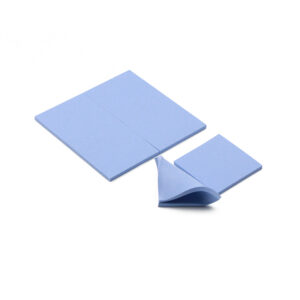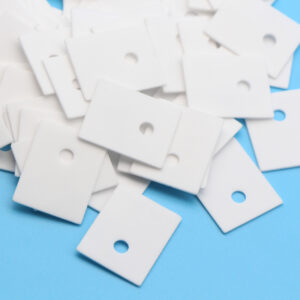Introduction:
Integrated circuits (ICs) have become the backbone of modern technology, powering everything from smartphones and computers to automobiles and medical devices. As ICs continue to shrink in size and increase in complexity, managing heat dissipation has become a critical challenge. Excessive heat can adversely affect the performance and lifespan of ICs, leading to reduced efficiency and even system failures. This is where IC thermal pads come into play, offering an efficient solution to effectively transfer heat away from these vital components.
Understanding IC Thermal Pads:
IC thermal pads are soft, compressible materials placed between ICs and heat sinks or other cooling components. They provide a thermally conductive pathway for heat to flow away from the IC and into the cooling system. Thermal pads are typically made from silicone-based materials infused with conductive fillers, such as ceramic particles or metal oxides, to enhance their thermal conductivity. Their soft and compliant nature allows them to conform to uneven surfaces and air gaps, ensuring optimal heat transfer.
Benefits of IC Thermal Pads:
- Enhanced Thermal Conductivity: IC thermal pads offer high thermal conductivity, allowing them to efficiently transfer heat from the ICs to the cooling system. This helps to prevent excessive temperature build-up, which can lead to thermal throttling or even permanent damage to the ICs.
- Easy Application: Unlike thermal greases or adhesives, thermal pads are simple to install. They come pre-cut in various sizes and thicknesses, ready to be placed between the IC and the heat sink. The ease of application saves time and reduces the risk of errors during the assembly process.
- Reduced Mechanical Stress: ICs are susceptible to mechanical stress caused by the differential expansion and contraction rates between the IC and the cooling system. Thermal pads act as a buffer, mitigating the stress and preventing potential damage that can occur due to the repeated thermal cycling.
- Electrical Isolation: In certain applications, where electrical insulation is required between the IC and the cooling system, thermal pads serve an additional purpose. The insulating properties of these pads prevent electrical contact and potential short circuits, ensuring the safety and reliability of the system.
- Reusability: Unlike thermal compounds that require cleaning and reapplication every time the IC is reassembled, thermal pads can often be reused multiple times. This makes them cost-effective and environmentally friendly.
Choosing the Right IC Thermal Pad:
When selecting an IC thermal pad, several factors should be considered:
- Thermal Conductivity: Look for pads with high thermal conductivity to ensure efficient heat transfer.
- Compressibility: Opt for pads with adequate compressibility to ensure good contact between the IC and the cooling system.
- Thickness and Size: Select pads of the appropriate thickness and size to match the requirements of your specific IC and cooling setup.
- Electrical Insulation: If electrical isolation is required, choose pads with suitable insulating properties.
Conclusion:
IC thermal pads have emerged as a reliable and effective solution for managing heat dissipation in modern electronics. By providing a thermally conductive pathway, these pads enhance the performance and longevity of integrated circuits, ensuring optimal functioning under demanding conditions. With their easy application, reusability, and ability to reduce mechanical stress, IC thermal pads have become an indispensable component in cooling systems. As technology continues to advance, the demand for efficient thermal management solutions will only grow, making IC thermal pads a vital tool in the pursuit of innovation.
Related Products

CTLC300 thermal pad
CTLC300 thermal pad is a general-purpose and economical thermal conductive gap filler, cost-effective, soft and self-adhesive, easy to assemble. It shows good thermal conductivity and electrical insulation performance under low compression force. It is placed between the heating device and the gap between the heat sink or the machine shell, and the air is squeezed out to achieve full contact, forming a continuous heat conduction channel. Using the heat sink or the machine shell As a heat dissipation device, the heat dissipation area can be effectively increased, thereby effectively improving the heat dissipation effect.

CTLCV-200S SIL PAD
CTLCV-200S High thermal conductivity SIL PAD is a kind of thin thermal conductive insulating material with excellent comprehensive properties, which is synthesized by special process with glass fiber as the base material, thermal conductive powder and high molecular polymer. This material has the advantages of high thermal conductivity, high friction resistance, high tensile strength and smooth and high adhesion surface, which can greatly reduce the interface thermal resistance under low pressure. It is widely used in the situation of high thermal conductivity and high electrical insulation. It is suitable for fixing components with low tightening pressure. It is mainly used between the heating semiconductor device and the heat dissipation substrate for heat conduction and insulation.

CTLT240 alumina thermal ceramic
The thermal conductivity of CTLT240 aluminum oxide is as high as 24W / MK. It is resistant to high temperatures and high pressure. The surface of the ceramic sheet is smooth without burr and burr. It is heated evenly and dissipates heat quickly; Simple and compact structure, small size, high strength, not easy to break, acid and alkali corrosion resistance, durable.

